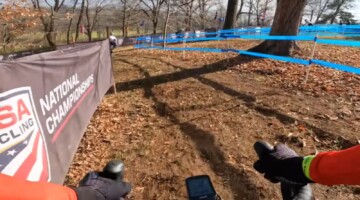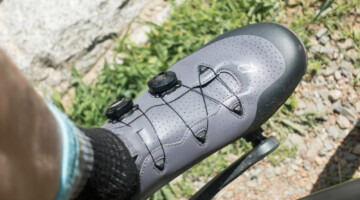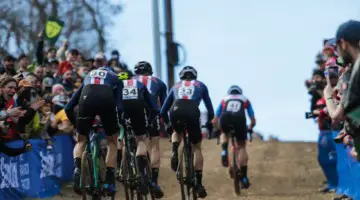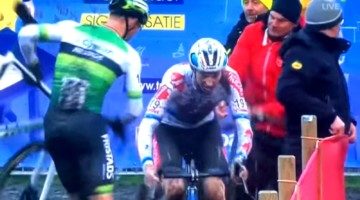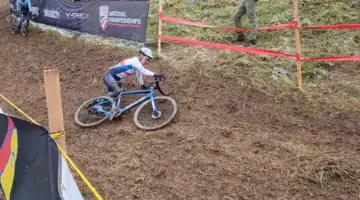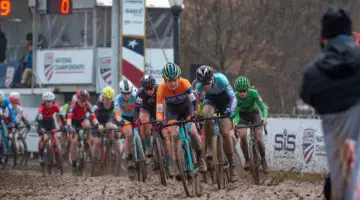by Kat Statman
From the USA Cycling Communique about proposed rule changes: “The USCF Board of Trustees will vote on several key issues when it meets in conjunction with the USA Cycling Local Associations on Nov. 6-7 in Colorado Springs. All USA Cycling members are encouraged to review the USCF Board of Trustees proposed 2010 legislation and contact your trustee representative to let your voice be heard on the outlined issues.”
We here at Cyclocross Magazine have gone through this 30 page document looking for the significant rule change proposals for ’cross so that you don’t have to. There are a couple that stand out clearly and will possibly be contentious issues among USA Cycling members if passed.
To clarify, we spoke with Shawn Farrell, technical director of USA Cycling. He emphasized that there are four potential outcomes for each proposal. The rule can: Be withdrawn; Pass as written; Fail (and get tossed out; Pass with amendments. The meeting this weekend will bring the regional trustees together to discuss and vote on each issue at hand. The trustees are taking feedback currently (email them via links above) and then will work with that info this weekend.
One of the more problematic or difficult proposed rule changes is that of field size. The proposed legislation states, “UR10.13 1J7 Cyclo-cross default field limit – David Miller and Tom Simonson. This creates a default field limit for cyclo-cross races. 1J7. Maximum Field. Entries shall be accepted in order of receipt by the organizer up to the field limit and subsequent entries shall be returned. The maximum field limit in any youth race or a road event exclusively for category 5 men or Category 4 women shall be 50 riders. The maximum field for a road event that includes category 5 men with other categories shall be 75. For other road events and for cyclo-cross events, if no field limit is given in the official race announcement, a field limit of 100 shall be used.”
What does this piece of proposed legislation purport to change for cyclocross events and who might it affect? Possible reasons for such a rule stem from the extremely large field sizes that were witnessed at the 2009 Cyclocross National Championships and many other USAC permitted events around the country where field size in some categories became a problem. For example, as reported on the forums of roadbikereview.com, a poster mentioned that for the Alpenrose Cross Crusade (though this is an OBRA and not a USAC event) there were 100 to 150 entries in at least six individual races held on that day. Participation numbers for the National Championship events and for series like the Verge New England Cyclocross Championship Series or the Mid-Atlantic Cyclocross races is similar. Fortunately, the proposed legislation is not a blanket cap at 100 for all cyclocross races and leaves the discretion up to the promoter when it says, “For other road events and for cyclo-cross events, if no field limit is given in the official race announcement, a field limit of 100 shall be used.”
Juniors: No carbon or tubulars!
Another important possible rule change affects the under 17 Junior riders. The rule takes away these group of racers ability to use both tubular wheels and composite wheels. The added restrictions are, “Effective Jan 1, 2012 the following additional restrictions apply to Juniors under the age of 17 competing in any race: i) Wheels must have at least 16 spokes. The rims must be made of metal – composite fibers (carbon etc.) are forbidden. Spoke covers are forbidden. ii) Only high pressure detachable tires shall be used, with the tube detachable from the tire. Such tires shall be beaded. Tubular tires are forbidden.” Though we are not privy to the reasoning behind each proposed rule change, it seems to be in line with equalizing the Junior fields in terms of equipment advantages. The racing in the Junior ranks is not supposed to be about who has the most money, but rather about supporting and sponsoring a nurturing and fun environment to promote Junior development and interest in the sport.
Singlespeed Championship
For all of you singlespeed racers, there’s some big possible news on the horizon that will have a serious consequence on your National Championship plans. The new proposed legislation with respect to singlespeed categories is labeled as emergency legislation and, if passed, will be effective as of December 2010. Here’s the proposal: “This adds single speed classes to cyclo-cross championships. We want it to be treated as emergency legislation to be effective for the 2010 championships. 8F8. National Cyclocross Championships shall be conducted for Elite men (cat 1-2), and Elite women (cat 1-3), Single Speed Elite men (cat 1-2) and Single Speed Elite women (cat 1-3).” If passed there will no longer be a blanket singlespeed free-for-all race, but an actual National Championship awarded to the best Elite male and female singlespeeders.
No Helmet Cams or Visors
Everybody loves the helmet cam videos that are seen over on the cowbell site, unfortunately USAC is proposing to ban helmet cams with rule UR10.19 1N1. But it’s not like your $200 investment will be useless if it passes, as this rule only bans helmet cams and not bar cams, seat cams, or any other place on your bike that you might place a camera. Sounds like visors are out too: “1N1. Helmets. At all times when participating in an event held under a USA Cycling event permit, including club rides, any rider on a bicycle or motorcycle shall wear a protective, securely fastened helmet that satisfies the standards specified in USA Cycling Policies. No additional component (helmet cams, visors, fairings) that was not initially manufactured with the helmet may be affixed to the helmet. The structure of the helmet may not be modified in any way. (Policy I, Sections 1 and 2 – see appendices.) [disqualification and a $20 fine for failure to wear or for removing such a helmet during a race. The fine is also applicable if the rider is not racing, but is participating in the event as described below]. “Participating in an event” means riding a bicycle in the vicinity of a race at any time between the beginning of registration and the last awarding of prizes, but does not apply to riding rollers or stationary trainers in order to warm up.” So Todd Wells and Adam Craig could still wear their visors to protect their eyes from all the splatter while riding on the trainer. Consistency in that helmet safety philosophy would suggest that means helmet lights would also be banned for 24 hour races (mountain, cyclocross or whatever else).
80% Rule and Pulling Riders
There are many other rule changes found in this document relating to cyclocross. The proposed legislation changes make it much more clear that the 80 percent rule is not a steadfast rule and it is up to the chief referee’s discretion. Proposed rule UR10.29 5G makes clear what the 80 percent rule says, “UR10.29 5G Cyclo-cross pulling riders – Tom Simonson This amends slightly the new rules adopted by telephone conference call in July. The July rules are black italic – the new section is in red. This makes the intent of the 80% rule clear. The wording about whether lapped riders are to be pulled or left in has been changed to a more neutral form. 5G. Finish 5G1. Unless announced otherwise, riders who have been lapped will be pulled from the race using the following procedures: Before the start of a race, it should be announced whether lapped riders will be pulled or remain in the race. If riders are to be pulled, the following applies: (a) Riders who have been lapped shall continue the lap to a designated location before the finish line and withdraw, under the control of the officials. (b) The Chief Referee may, after consulting with the organizer, impose the 80% rule. Under this rule, riders whose time gap to the race leader is at least 80% of the race leader’s time for the first lap will be pulled by the officials unless it is the final lap. The number of 80% is merely an approximation based on a typical course; the intent is that all riders should be pulled before they are lapped. (c) Riders who have been pulled because of lapping or the 80% rule will be listed in the results based on their position when pulled and the number of laps remaining. The results will list the number of laps remaining after the lap on which they were pulled.”
Fixie Hipsters Need Not Apply
Also Fixed gear bicycles will not be allowed in cyclocross events, all bikes must have a freewheel and two brakes: UR10.18 1M3 Cyclocross bikes – freewheel – Tom Simonson. This makes it clear that all cyclo-cross bikes must have a freewheel. 1M3. Bicycle Types (a).. (b) For road, cyclocross (including single speed classes) and MTB races, only a bicycle with a freewheel and one working brake on each wheel shall be used, except as allowed elsewhere in these rules.” Just when fixed-gear cyclocross was about to jump the shark!
With this meeting happening this week, take the time to contact your local USA Cycling representative and make sure your voice is heard. Also please comment below, let us and others know what you are thinking, and keep the discussion about the direction American cyclocross racing is going alive and thriving.
























